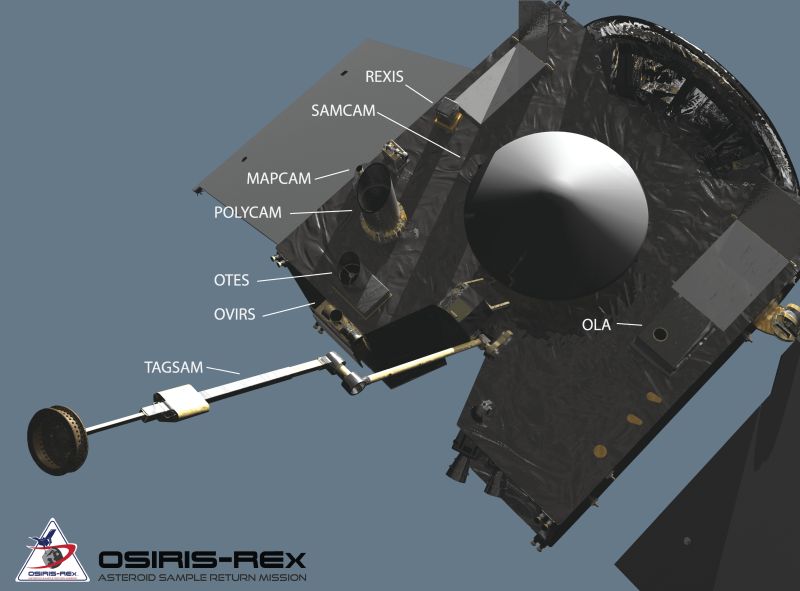NASA's
OSIRIS-REx
spacecraft has reached its destination and is now in orbit around asteroid
Bennu
. The spacecraft travelled for over two years and covered more than 2 billion kms. It will spend a year in orbit, surveying the surface of the Potentially Hazardous Object (PHO) before settling on a location for the key phase of its mission: a sample return to Earth.
OSIRIS-Rex (Origins, Spectral Interpretation, Resource Identification, Security, Regolith Explorer), if successful, will be the first US spacecraft to return an asteroid sample to Earth. The $800 million mission was launched in September of 2016, and if all goes according to plan, it will return a sample to Earth in September, 2023. The sample will be small—only 60 grams, or 2.1 oz.—but that's enough material to meet the missions goals.
Below is a series of images taken by OSIRIS-REx at a distance of about 80 km (50 mi.) The images constitute one full revolution of the asteroid.
https://gfycat.com/SafeCostlyAnnashummingbird
Why Did NASA Send OSIRIS-REx to Bennu?
NASA targeted Bennu for its sample mission for a number of reasons. First of all, Bennu is old, really old. Scientists think it might be older than the Solar System itself, which is about 4.6 billion years ago. At that age, it holds clues to how the Solar System formed, clues that aren't available here on Earth because of Earth's geological activity and living processes.
Bennu is also close to Earth. So close that it's considered a Potentially Hazardous Object (PHO), an object with an orbit that brings it close to Earth, and that's large enough to do serious damage if it struck. (Relax. They don't think it will.) Its closest approach to Earth is every six years and it orbits the Sun on the same plane as Earth. Its proximity to us made it a prime target for OSIRIS-REx.
For a sample-return mission, the asteroid has to be the right size. Too small, around 200 meters or less in diameter, and it spins so fast you can't land on it. The rapid rotation also sends small rocks on the asteroid's surface flying into space, meaning there's nothing there for the spacecraft to collect. Bennu's almost 500 meters in diameter, and rotates only once every 4.3 hours. It's easier to land on, and once on the surface, there will be plenty of material to sample.
Asteroids may have played a role in the origins of life here on Earth by delivering
organic molecules
to our planet in its early days. Astronomers have studied Bennu intensely from a distance, and they know that it's a carbonaceous, or carbon-rich, asteroid. Carbon is the key to the organic molecules needed for life, so finding organic molecules on a sample from Bennu would help to answer a big question about the origin of life.
There are a host of other reasons that NASA chose Bennu, and you can read about them all
here
.
Below is a gif of the spacecraft's approach to Bennu, from a distance of 2.2 million km (1.4 million miles) to 65 km (40 miles.)
https://gfycat.com/NeglectedBountifulEyas
How Will OSIRIS-REx Return a Sample to Earth?
OSIRIS-REx is in no hurry. It will spend a year studying Bennu from orbit. It has a nice suite of instruments to do its work. It has three different cameras, a laser altimeter which will allow it to map the surface of the asteroid in exquisite detail, to help choose a landing site. It has three spectrometers: a visible and infrared one, a thermal spectrometer, and an X-ray spectrometer.
[caption id="attachment_140750" align="alignnone" width="800"]
OSIRIS-REx and its instruments. Image: NASA/University of Arizona[/caption]
Lots of spacecraft have cameras and spectrometers, and laser altimeters are becoming more common, but the main focus of OSIRIS-REx is sample-return. To do that it has a specialized piece of equipment called TAGSAM, or Touch-And-Go Sample Acquisition Mechanism. TAGSAM is the heart of the spacecraft's mission. It consists of a sampling head and an arm that is 3.35-meter (11 ft) long. The sample-return will work like this:
- OSIRIS-REx will slowly approach Bennu, at a speed of only 0.2 meters per second.
- The spacecraft will land on the asteroid within 25 meters of its selected landing spot
- The cameras will begin recording the sampling site and its surroundings.
- The sampling arm will contact the surface of Bennu for five seconds.
- It will release a blast of liquid nitrogen which will stir up dust.
- The dust will be captured in the sampler head.
- The sampler head is stored in the Sample-Return Capsule (SRC) and OSIRIS-REx will return to Earth.
- The SRC will separate from the spacecraft and enter Earth's atmosphere, to be collected at the Utah Test and Training Range.
This summary might make the mission sound simple, but of course its not. A lot has to go right for NASA to get its sample back to Earth. But NASA are the experts when it comes to landing spacecraft on other bodies, as the recent successful
landing of the INSIGHT lander
on Mars shows us.
Let's hope NASA gets it right again, because that small sample, between 60 and 2000 grams in weight, could provide some big answers to some big questions.
Sources:
- NASA Press Release: OSIRIS-REx Arrives at Bennu
- NASA Feature: Why Bennu? 10 Reasons
- NASA's OSIRIS-REx mission home page: OSIRIS-REx Overview
- Wikipedia Entry: OSIRIS-REx
- Wikipedia Entry: 101955 Bennu
- NASA page: Bennu
 Universe Today
Universe Today

